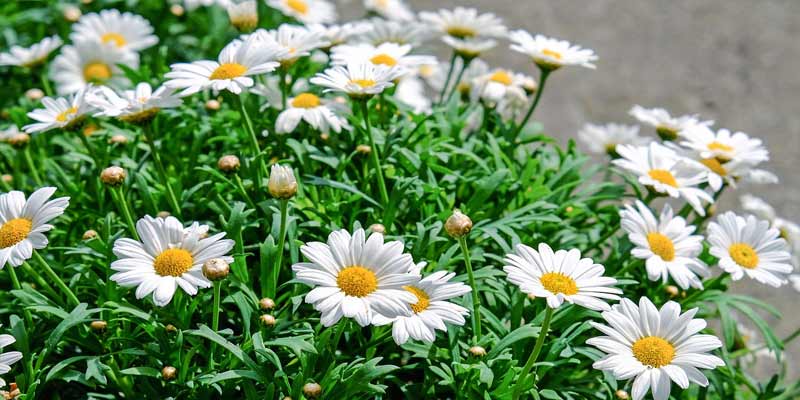The gardening world holds a deep affection for daisies, charmed by their timeless appeal and cheerful demeanor. Bringing whimsy to gardens, meadows, and landscapes globally are the simple yet elegant blooms of these charming flowers. Gardening enthusiasts often find themselves curious about one question in particular: when precisely do daisies bloom?
In this article, we initiate a quest to decipher the enigmatic daisy bloom times. We delve into the factors–those that wield influence on their flowering patterns; and offer insights – strategies for maximizing these delightful blooms’ beauty.
The Diversity of Daisy Species
Recognizing the diversity within the daisy family is crucial before delving into the timing of its blooms. The Asteraceae family, to which daisies belong, encompasses a vast array of species; each possesses unique characteristics and blooming habits. Daisies—from classic English (Bellis perennis) to vibrant Shasta (Leucanthemum x superbum), even exotic African ones like Osteospermum—present themselves in various shapes sizes, and colors.
Understanding the Blooming Cycle
A fascinating phenomenon, the blooming cycle of daisies, hinges on a trifecta: environmental factors; seasonal changes, and intrinsic biological rhythms within the plants. Depending on species and growing conditions—specific blooming times may vary—but typically follow a predictable pattern for growth and flowering.
Spring Blooms: A Symphony of Renewal
The vibrant blooms of many daisy species herald their arrival in spring as temperatures rise and daylight hours extend. These daisies awaken from a winter slumber. They embark on an intensive journey marked by growth, and renewal; indeed, it is during this period that certain varieties such as English daisies and select Shasta variants burst forth with clusters of delicate flowers painting white-yellow-pink shades across the landscape.
Spring’s onset triggers daisy plants’ physiological cascade, prompting the emergence of new shoots and flower buds. Seizing the opportunity as soil temperatures warm and frost recedes, daisies unfurl their petals to bask in the sunlight’s gentle warmth. Blooming in spring symbolizes not only hope but also rejuvenation; it promises brighter days ahead while infusing gardens with an air of vitality – an embodiment that embodies optimism itself.
Summer Splendor: Peak Bloom Season
Spring’s transition to summer prompts daisies to peak in bloom, releasing an abundant array of color and fragrance across the landscape. Many varieties of Shasta daisies and African daisies, known as summer-blooming species, flourish amid the longer daylight hours and warmer temperatures that mark these months.
During this time, daisy plants energetically produce an abundance of flowers; they attract pollinators and enchant admirers with their exuberant displays. Daisies, whether in sprawling meadows or cottage gardens – cast a spell on outdoor spaces: an air of enchantment that beckons bees, butterflies, and birds to partake in nature’s bounty.
Fall Farewell: A Seasonal Transition
While some varieties of daisies may continue to bloom sporadically into the fall months, many undergo a gradual transition as summer wanes and temperatures begin to cool in preparation for autumn’s onset. Their flowering tapers off gradually with the dwindling daylight hours and dropping temperatures.
Certain cultivars of Shasta daisies and aster varieties, fall-blooming daisies, extend the growing season with their late-season blooms. They offer a final burst of color before winter’s chill arrives; moreover, as autumn leaves adorn landscapes in gold and crimson hues – these vibrant flowers add an extra touch to fading gardens. In doing so, they serve as poignant reminders: nature operates on cyclical rhythms.
Factors Influencing Daisy Blooms
Several factors influence the timing and duration of daisy blooms, including:
Species Variation: Various daisy species, each with its unique preference, favor blooms either in spring or summer; on the other hand, some thrive amidst fall’s cooler temperatures.
Climate: Regional climate and local growing conditions significantly determine the timing of daisy blooms. Daisies cultivated in temperate climates might bloom earlier or later compared to those grown in warmer or cooler regions.
Day Length and Light Exposure: The flowering response of daisy plants hinges on the duration of daylight hours and their exposure to sunlight; indeed, ample sunshine during longer days stimulates increased flower production.
Moisture: Adequate soil moisture and nutrient availability play an essential role in supporting the healthy growth and flowering of daisies; thus, these resilient plants thrive best within a well-drained soil abundant with organic matter, an ideal growing environment tailored to their needs.
Tips for Maximizing Daisy Blooms
To ensure optimal blooming and prolonged flowering periods, consider the following tips:
1. Choose suitable varieties: Select daisy species—considering their blooming times, cultural requirements, and your specific climate and growing conditions; ensure they are well-suited.
2. Provide Adequate Care: Ensure you consistently maintain practices such as watering, fertilization, and soil management; these actions will promote not only healthy growth but also abundant flowering throughout the entire growing season.
3. Deadheading: Promptly remove faded flowers to stimulate continuous blooming and deter seed formation; this redirects the plant’s energy toward generating new blooms, which is a process known as ‘deadheading’.
4. Actively Monitor Environmental Conditions: Vigilantly track shifts in weather patterns, fluctuations in temperature, and transitions between seasons; then adjust your gardening practices accordingly–thus bolstering the health and vitality of daisies.
Conclusion
In conclusion, we find the captivating spectacle of daisy blooms unfolding in perfect timing against changing seasons and natural rhythms. Spring introduces us to delicate blossoms; summer displays bountiful shows, fall continues this display with lingering beauty. Each season’s ephemeral allure allows for a deeper appreciation when understood through understanding factors that influence their blooming cycles. It is an invitation not just from these beloved flowers but also from nature itself – urging us towards embracing its wonders more fully.
Whether you tend to a cottage garden, nurture a wildflower meadow, or care for daisies in your window box, take pause – marvel at the splendor of nature’s floral tapestry. Rejoice in simple pleasures; there is beauty even within the humblest blooms.



Leave a Reply